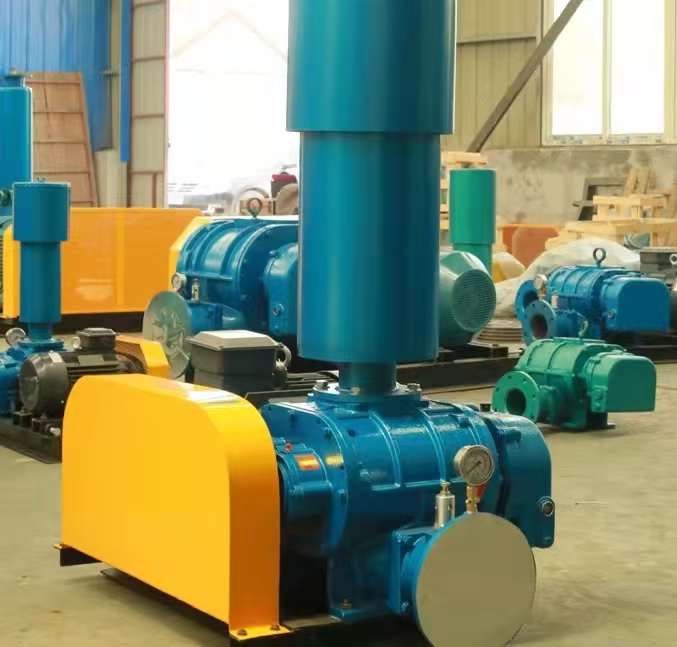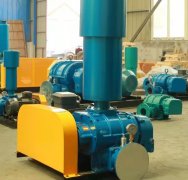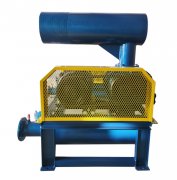The following is a disassembly explanation and analysis of the core components of the three leaf Roots blower, to help you understand its internal structure and working principle:
---
**1、 Core structure diagram of three leaf Roots blower (schematic diagram)**
Due to the inability to directly display images, the main components and their positional relationships are described in text here:
1. * * Shell (cylinder) * *: Made of cast iron or stainless steel, with a dual chamber structure inside to accommodate the rotor.
2. * * Three bladed rotor * *: Two interlocking "three bladed" rotors that rotate in opposite directions synchronously through gears.
3. * * Synchronous gear * *: located at the end of the rotor shaft, ensuring that the two rotors maintain a fixed phase difference (usually 20 °~30 °).
4. * * Bearings and Seals * *: Support the rotor shaft to prevent gas leakage (commonly used mechanical seals or labyrinth seals).
5. * * Import and export muffler * *: reduces airflow pulsation noise.
---
**2、 Disassembly steps and detailed explanation of components**
**1. Preparation before disassembly**
-* * Tools * *: wrench, puller, copper rod, lubricant cleaning agent.
-* * Measures * *: Power off, exhaust pipeline gas, mark component assembly sequence.
**2. Disassembly process**
1. * * Dismantle peripheral attachments**
-Remove the inlet and outlet muffler, belt/coupling protective cover.
-Disconnect the oil pipe and pressure gauge pipeline.
2. * * Separate the casing**
-Loosen the connecting bolts of the casing and use a top screw to evenly open the upper and lower casings (pay attention to the protection of the sealing gasket).
3. * * Remove the rotor assembly**
-Remove the synchronous gear end cover and record the gear meshing marks.
-Use a puller to pull out the rotor shaft (avoid hitting the impeller).
4. * * Disassemble core components**
-* * Rotor * *: Check for impeller wear and clearance (standard clearance 0.1~0.4mm).
-Gearbox: Check the wear and lubrication status of the gears.
-* * Bearing * *: Measure the clearance and replace if there is looseness or abnormal noise.
---
**3、 Key component functions and maintenance points**
|* * Component * * | * * Function * * | * * Maintenance Points * *|
|-----------------|------------------------------|-------------------------------|
|* * Three leaf rotor * * | Gas delivery core determines air volume | Regularly clean accumulated dust and check gap wear|
|* * Synchronous gear * * | Ensure rotor phase synchronization | Change lubricating oil every 2000 hours|
|* * Bearing * * | Supporting rotor rotation | Monitoring temperature, adding lubricating grease every 6 months|
|* * Chassis sealing * * | Prevent gas leakage | Replace aging sealing strips or gaskets|
|* * Muffler * * | Reduce exhaust noise | Regularly clean internal fiber materials|
---

**4、 Assembly precautions**
1. * * Rotor installation**
-The gears must be aligned according to the original markings, as misalignment can cause impeller collision.
-Confirm that the manual turning is flexible and unobstructed in rotation.
2. * * Gap adjustment**
-Use a feeler gauge to check the gap between the rotor and the casing. If it exceeds the tolerance, it needs to be ground or replaced.
3. * * Sealing test**
-After assembly, an air tightness test (soap water leak detection) is required.
---
**5、 Common faults and disassembly associations**
-* * Decreased air volume * *: may be due to increased rotor clearance or clogged filter screen (rotor and intake system need to be disassembled and inspected).
-Abnormal vibration: Bearing wear or poor gear meshing (with a focus on inspecting the gearbox).
-High temperature alarm: Insufficient lubricating oil or seal friction (disassembly of lubrication and cooling system).
---
**6、 Professional advice**
-Non professionals should be cautious when disassembling: Precision assembly requires specialized tools and techniques, and incorrect disassembly may result in the scrapping of the fan.
-* * Spare parts replacement * *: It is recommended to use original parts, especially rotors and gears (high-precision matching).
If you need a specific model's structural diagram, you can provide the fan brand and parameters for further analysis!



